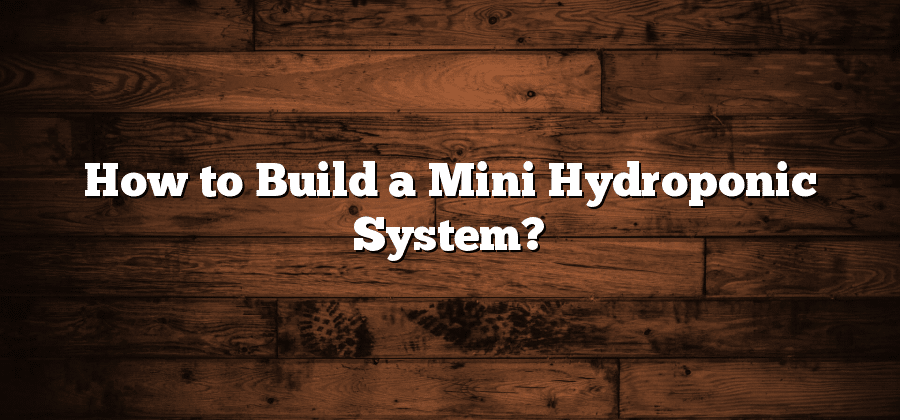Setting up the Foundation of Your Mini Hydroponic System
When it comes to setting up the foundation of your mini hydroponic system, there are a few key steps that you need to follow to ensure success. Firstly, you’ll need to determine the location for your system. This should be a well-lit area, ideally with access to natural sunlight or artificial grow lights. Once you’ve chosen the location, you can begin assembling the necessary equipment. This may include a reservoir, a pump, an air stone, and a timer. Take your time to gather all the components and ensure they are of high quality for optimal performance.
Next, it’s important to get familiar with the basic principles of hydroponics. This method of growing plants without soil relies on a nutrient-rich solution that is continuously supplied to the plant’s roots. Understanding the science behind hydroponics will help you make informed decisions throughout the setup process. Take the time to research and learn about the types of nutrients that plants require, as well as the importance of pH levels and oxygenation. Armed with this knowledge, you’ll be better equipped to provide the best conditions for your plants to thrive.
Choosing the Right Container for Your Hydroponic System
When it comes to setting up a hydroponic system, choosing the right container is an important decision that can greatly impact the success of your plants. There are various factors to consider when selecting a container for your hydroponic system, such as size, material, and drainage capabilities.
The size of the container is crucial because it determines how much space your plants will have to grow and develop their root system. It is important to choose a container that is large enough to accommodate the size and number of plants you intend to grow. Additionally, consider the dimensions of the space where you plan to set up your hydroponic system. Ensure that the container fits comfortably within the available space, allowing room for easy access and maintenance.
Selecting the Appropriate Growing Medium for Your Plants
When it comes to setting up a hydroponic system, one of the key factors to consider is the selection of an appropriate growing medium for your plants. The growing medium serves as a support system for the roots, providing stability and oxygenation. It also plays a crucial role in nutrient absorption and moisture retention.
There are several options available for growing mediums in hydroponics, each with its own pros and cons. One commonly used medium is expanded clay pebbles, which are lightweight and have excellent drainage properties. Another popular choice is rockwool, a synthetic material that can retain moisture while also providing good aeration. Other options include coconut coir, perlite, and vermiculite, each offering different benefits depending on the specific needs of your plants. It is essential to consider factors such as water retention, pH levels, and the specific requirements of your plants when selecting the growing medium for your hydroponic system.
Understanding the Importance of Nutrient Solution in Hydroponics
The nutrient solution is the lifeblood of any hydroponic system. Unlike traditional soil-based gardening, where plants can draw nutrients from the soil, hydroponics relies on a carefully crafted solution to provide the necessary elements for optimal growth. This solution consists of a precise blend of minerals and nutrients that are dissolved in water and directly delivered to the plant roots. By ensuring that all essential elements are readily available in the right quantities, hydroponic growers can maximize plant health and productivity.
Having a thorough understanding of the nutrient solution is crucial for hydroponic success. It is not enough to simply mix together some fertilizers and water; a well-balanced and tailored solution is key. The composition of the solution will depend on the specific needs of the plants being grown, as different plants require varying amounts of nutrients at different stages of growth. Moreover, maintaining the correct pH level of the solution is vital to ensure that the plants can properly absorb the nutrients. By carefully monitoring and adjusting the nutrient solution, hydroponic growers can create an optimal environment for their plants to thrive and produce bountiful harvests.
Determining the Ideal pH Level for Your Mini Hydroponic System
Determining the ideal pH level for your mini hydroponic system is crucial for the health and productivity of your plants. pH is a measure of how acidic or alkaline a solution is, and it plays a vital role in nutrient availability and absorption by plant roots. The pH scale ranges from 0 to 14, with 7 being neutral. In hydroponic systems, the ideal pH range typically falls between 5.5 and 6.5. This slightly acidic environment facilitates the best nutrient uptake and mineral absorption by the roots.
Maintaining the correct pH level in your hydroponic system requires regular testing and adjustment. There are several methods available to measure pH, including pH test strips or digital pH meters. Once you have determined the pH of your system, you may need to make adjustments using pH up or pH down solutions. Higher pH levels can be lowered by adding pH down solution, which usually contains phosphoric acid. Lower pH levels can be raised by adding pH up solution, typically made with potassium hydroxide. It is important to make gradual adjustments and regularly monitor the pH level to ensure it remains within the optimal range. By taking the time to determine and maintain the ideal pH level for your mini hydroponic system, you will be setting the stage for healthy and thriving plants.






